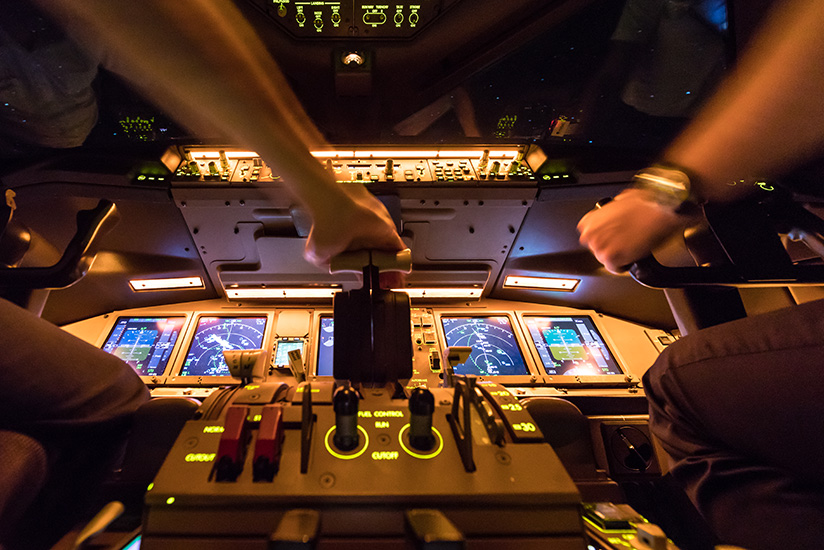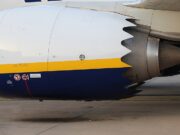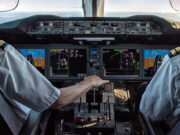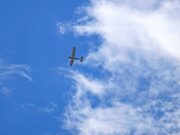
Image: © Rathke | iStockphoto
This article is the sixth in a series on landmark events in aviation since Flight Safety Foundation was founded in 1945.
For much of aviation’s history, flying an aircraft required a constant scan from one side of the main instrument panel to the other. Pilots monitored separate round gauges for each flight parameter. Those flight instruments became known as the “six-pack” — airspeed indicator, altimeter, vertical speed indicator, turn coordinator, heading indicator, and attitude indicator. (If the pilot was lucky, all six instruments were on the instrument panel. But the earliest fliers managed without a gyroscopic heading indicator and got along instead with a simple magnetic compass, bouncing around in its fluid during turbulence.)
In addition to the six-pack of instruments, there was also the need to scan engine and systems instruments, which might be anywhere: on the main panel, an overhead panel, or a center console. Where were the oil pressure gauges? Maybe obstructed by the copilot’s knee. What about the warning lights for generator failure? Somewhere overhead, and they didn’t tell a pilot a thing if the pilot didn’t see them. Even a dedicated flight engineer, a specialist in monitoring and operating systems, could miss something. Did that dancing ammeter indicate an electrical problem? Only if it was noticed among the forest of other gauges and switches.
David Morrison, one of the founders of Flight Safety Foundation, noted the bewildering arrangement of analog displays in the early 1940s while working with a U.S. Navy cockpit safety program. He determined that many accidents that had been attributed to pilot error actually resulted from poor cockpit ergonomics, the scattering of displays around the cockpit, and the lack of instrument panel standards. In response, in 1945, he patented a prototype that integrated the analog displays into a single digital instrument readout.
By the 1970s, the cathode ray tube enabled manufacturers to begin re-engineering flight instrumentation, creating designs more compatible with the human eye — and mind — and more in line with Morrison’s vision.
Later developments used multicolored liquid crystal display screens that offered even more flexibility in crafting easy-to-read presentations. Flight data presented on flat screens rather than round gauges became known as electronic flight instrument systems. As screens also replaced systems gauges, making flight decks far less cluttered, the phrase “glass cockpit” took hold.
Research by the U.S. National Aeronautics and Space Administration (NASA) and other entities found several advantages to flight data presented on glass screens. They included:
- Values were easier to read due to the absence of parallax errors and the use of precise numerical values.
- More data occupied less space, allowing more efficient scanning.
- Different layers of information could be displayed on the same screen; for example, weather or terrain data could be overlaid on a horizontal situation display.
The Airbus A320 was the first airliner built with a full glass cockpit and digital fly-by-wire flight controls.
Airbus began taking orders for the A320 in 1984.
Glass cockpit designs have taken different forms over the years. However, a fairly standard configuration for airliners includes a primary flight display and a multifunction display (MFD) on both the captain’s and first officer’s sides of the flight deck. The MFDs can show navigational data as well as synoptic pages for various aircraft systems.
In addition, a single centrally located engine indicating and crew alerting system (EICAS) screen displays engine instrumentation. The EICAS also displays systems cautions and warnings in plain text form.
Regulators have established certain standards to ensure the reliability of glass cockpit systems. For example, guidelines from the U.S. Federal Aviation Administration ensure the screens won’t go blank during power transients (surges in electrical voltage). Requirements include a provision that a liquid spill in the flight deck should not create a hazard, and the displays should not be susceptible to electromagnetic interference from other aircraft systems. Guidelines also include display readability in varied light conditions. In addition, designs must allow for fault isolation, so that a single failure won’t blank out all the screens, and redundancy, such as standby flight instruments.
As the technology matured, Flight Safety Foundation published leading articles about the impact on human factors. Did glass cockpit technology make flying too easy? A 1989 Foundation article titled “Communications and Decision Making in the Glass Cockpit” discussed the issue. The piece described how automation had changed a pilot’s role “to that of a systems manager whose primary task is to monitor the aircraft displays and detect any deviations. … This is a classic vigilance task.” The article added: “There are numerous instances where the inherent limitations of humans in monitoring automated systems have led to accidents or near accidents, particularly when combined with the effects of fatigue or circadian dysrhythmia.”
In other words, pilots aren’t wired to just sit there and watch. The article went on to suggest a possible solution to overreliance on automation: Let pilots use as much or as little automation as they wish. The article quoted Professor Earl Wiener of the University of Miami and NASA’s Ames Research Center. “The pilot should fly in a manner he sees fit, using cockpit resources as he deems necessary,” Wiener said.
Glass cockpit technology drove a reduction in airline flight deck crews from three people to two: the second officer, or flight engineer, was eliminated. A 1992 Foundation article considered the resulting workload on the captain and first officer. The study measured workload as defined by pilots’ heart rate during certain tasks. The project, conducted at Britannia Airways, compared data with the then-new Boeing 767 with data from the older technology 737-200.
“Results from a total of 73 flight sectors strongly supported numerous anecdotal reports from company pilots that levels of workload in the 767 are almost always noticeably lower than in the 737,” the article said. However, the article also noted that data suggested automation can decrease workload for the pilot flying while increasing workload for the pilot not flying (now known as the pilot monitoring). The piece also contrasted the Britannia study with a NASA study based on interviews with Boeing 757 pilots. About half the pilots said automation did not reduce their workload.
Britannia conducted further research measuring pilot heart rates during abnormal operations in a 767 simulator. The report said findings favored glass cockpit technology. “With regard to the relationship between workload in the glass cockpit and fatigue or tiredness, the evidence available suggests that boredom and under-arousal, associated with a lower level of workload, is the main problem,” the article stated.
In 1999, a Foundation report considered the training issues for pilots transitioning from legacy cockpits to glass. To a pilot who had spent years flying on six-pack gauges, a glass cockpit might have presented a steep learning curve. The report, titled “Transition to Glass: Pilot Training for High-Technology Transport Aircraft,” looked at the challenges faced by Continental Airlines as it acquired aircraft such as the Boeing 757.
The report described some of the concerns: “Would the average pilot be able to manage the automation and its many modes? Would the hardware and software be able to live up to its claims for workload reduction, thus making it possible to eliminate the flight engineer’s position, and fly large jet aircraft, over oceans, with a two-pilot crew? Would automated flight invite operator “blunders” (large errors) as seen in other applications of automation?”
The study involved questionnaires given to pilots during three phases: the first day of transition training, approximately three to four months after training, and approximately 12 to 14 months after initial operating experience. In-person and telephone interviews were also conducted with line pilots, instructors, and check airmen.
The report concluded that many of the problems experienced in the early years of the glass cockpit had been overcome. “The failure rate today in first-time glass transition is about the same as in traditional aircraft, less than 1 percent,” the report said.
Glass cockpit displays can now present virtually anything and everything to do with an aircraft’s performance and status. That capability has led researchers to ask: How much is too much? A 2012 article in Flight Safety Foundation’s AeroSafety World magazine addressed the problem of sensory overload. Though pilots might consider themselves masters of multitasking, the article, titled “Attention on Deck,” noted: “Attention is limited, and attention is selective.”
But, the article said, the issue is more complex than simply dividing a finite pool of attention. Author Clarence E. Rash, a military aviation researcher, cited three dimensions to a given task that determine how attention gets allocated. These dimensions were based on work by aviation psychologist Chris Wickens:
- What processing stage does the task involve — for example, noticing a light or flipping a switch?
- Does the task involve verbal or spatial processing — for example, listening to a communication or reading an instrument?
- What types of input and output are involved — auditory or visual inputs; verbal or motor outputs?
Further, Rash discussed other factors including:
- Selective attention: the process of choosing what to attend to. Selective attention enables a person to concentrate on an item of interest while ignoring other inputs such as engine noise or cabin conversation.
- Attention tunneling: fixating on a specific input to the exclusion of other important inputs.
- Sensory overload: too many inputs; for example, multiple chimes and warnings during a complex emergency.
Rash noted that reviews of the U.S. National Transportation Safety Board aviation accident database showed nearly half of accidents could be attributed to crew error involving attention lapses. Human factors research, the article said, can lead to improvements in how to present information on the flight deck. “Better guidelines,” Rash added, “coupled with the flexibility of glass cockpits that are no longer constrained in the type and location of the information they present, may help reduce the potentially disastrous consequences of sensory overload and attention tunneling.”
In short, human factors research continues to advance along with technology, helping make flight decks more physically and mentally ergonomic, thereby improving safety.
Thomas W. Young is a retired airline captain and a former instructor flight engineer with the West Virginia Air National Guard. Young has logged nearly 12,000 hours of pilot and flight engineer time.


